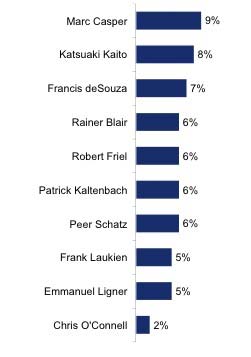No matter what we research, or where in the world we complete our work, as scientists we are also consumers. At The Science Advisory Board we surveyed 1,000 scientists from across the globe. The goal of this study was to better understand how our members respond to a variety new ways lab suppliers market their products. This piece is a valuable resource if you are interested in comparing the consumer behavior of your lab with your peers elsewhere.
No matter what we research, or where in the world we complete our work, as scientists we are also consumers. At The Science Advisory Board we surveyed 1,000 scientists from across the globe. The goal of this study was to better understand how our members respond to a variety new ways lab suppliers market their products. This piece is a valuable resource if you are interested in comparing the consumer behavior of your lab with your peers elsewhere.
A Demographic Inflection Point
We must find a way examine the scientific population and to divide our members into more homogeneous groups. Our Vice President, Publications, Dr. Robin Rothrock believes “by far, the most interesting and perhaps most actionable results can be viewed through the filter of age.” The “data suggests that a demographic inflection point has been reached in the scientific population, and not just in North America. The Boomers are starting to retire. And the Millennial’s are working their way through graduate school and beginning their careers in scientific research. These differences are reflected in customer preferences for how they want to interact with vendor-created content in addition to the nature of the content they want to consume.”
You may not even realize it, but as a scientist and researcher you too are a part of generational marketing. Brand messages are directed to different cohorts. This technique is based on the concept that every generation has distinct experiences, shared memories and values that shape their expectations and influence their buying behavior.
Statistically speaking, in the US, the life science workforce is aging – a reflection of overall population trend. As older scientists retire, newly trained scientists come in with updated lab skills and new approaches to problem solving. Europe and Japan, strongholds of the life science instrument and service development, are also being challenged by the influxes of fresh talent present in newer, quickly growing life science arenas, such as China.
Much of the research and literature about generational marketing is US-centric. It is beyond the scope of our study to validate these stereotypes or examine how they differ one a regional or global basis. Current research suggests that Boomers value individualization, self-expression, optimism and the advancement of their careers. Gen X’ers are stereotyped as less traditional and as a group that highly values career goals. Millenials, the children of the boomers can be characterized as self-reliant and optimistic. Xennials, the “microgeneration” between Millennials and Gen X’ers possess a mix of Gen X cynicism and Millennial optimism.
Let’s Talk about Executive Branding
Executive branding is when senior leaders at a company elevate and promote their visibility for the benefit of the company. Their industry expertise, beliefs and commitment to their customers are highlighted across multiple media channels and become a personification of their brands.
When executive branding is used effectively, the company’s leadership, especially the CEO, is placed squarely in the foreground to give customers a human reference point to their product decisions and the values of the brand.

The results are in, and we found that fewer than 10% of our members surveyed could correctly match the name of a life science executive with the company they lead.

This may seem surprising, but our members shared they consider their tech support rep to be the greatest touch point when talking about the company’s products. When asked what subjects our members would be interested in hearing about from senior executives the responses included new products to fuel their research, possible collaborations, and funding to accelerate their research.
We also recognize a real difference between how Millenials would like to engage with life science executives compared to Boomers. Millenials are twice as likely to read the executive’s blog or follow him or her on social media than their older colleagues.
Check out our other posts about how the consumerist culture plays a role, even in the life sciences. Share your thoughts on this post below!
Copyright © 2018 scienceboard.net



